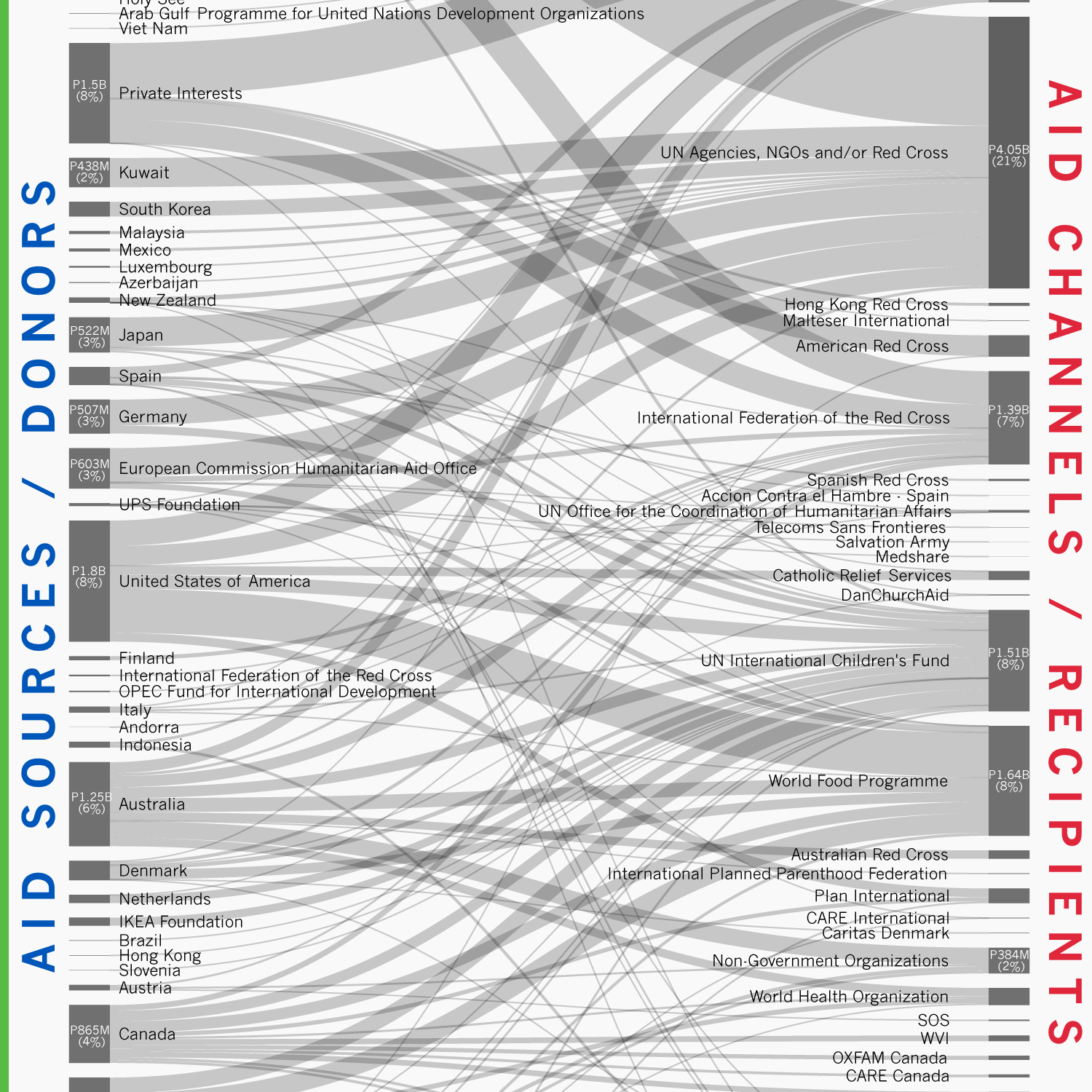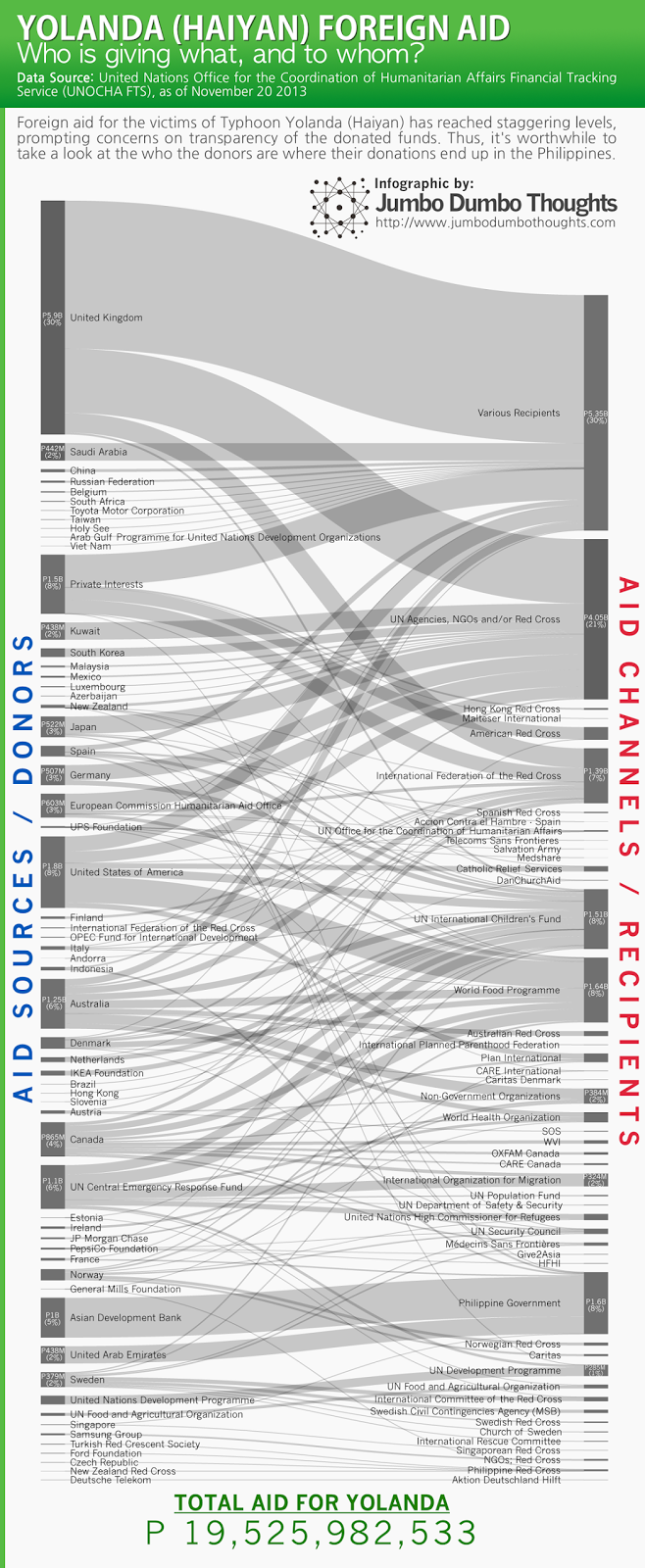Information and links may be outdated.
On Yolanda (Haiyan) Foreign Aid: Who is giving what, and to whom?

Foreign aid for the victims of Typhoon Yolanda (international name Haiyan) has reached staggering levels, with the United Nations Office for the Coordination of Humanitarian Affairs pegging the value at P19.53 billion. Data on these massive aid flows can be visualized to show the donors, and through which channels the donations were made.
Money in motion

An Australian aid worker receives a briefing from the mayor of Guiuan, Eastern Samar, where Yolanda first made landfall. (Photo: AUSAID/Flickr, CC BY 2.0)
When Typhoon Yolanda (Haiyan), the strongest typhoon to ever make landfall, cut through the central Philippines last November 8, 2013, it caused damage of unprecedented proportions. The most recent National Disaster Risk Reduction Management Council (NDRRMC) estimates place the death toll at 5,235 and damage of P22 billion, making it the third costliest typhoon in the Philippines.
If there is a silver lining to this disaster, however, it is the overwhelming response of the international community to the disaster. Foreign aid has reached P19.5 billion as of November 20, 2013, according to the UNOCHA Financial Tracking Service. However, concerns arise regarding how these aid flows are being managed and delivered, and it’s useful to take a look at how aid money is flowing though the system, which we can visualize using data from the UNOCHA-FTS 1:

Developed country aid
The major donors include: the United Kingdom (P5.9B), the United States (P1.8B), Private Interests (P1.5B), Australia (P1.25B), the UN Central Emergency Response Fund (P1.1B), along with several European and Middle Eastern countries.
Malversation blues
The largest aid channels are UN agencies, Red Cross organizations, the Philippine government, and Non-Government Organizations.
Many are worried that these aid contributions, when coursed through the government, won’t reach intended beneficiaries. The Philippine government has received a significant amount - around P1.6 billion or 8% of total aid provided - but not a majority of foreign aid. This has come mainly from the Asian Development Bank and the United Arab Emirates. However, the largest yet undisclosed “Various Recipients” category may change these facts.
Thanks for reading! If you found this post informative, I’d appreciate it if you liked, shared, tweeted, or +1’ed it on your preferred social network
Explore the data
If you’d like to explore the data in more granular data, you can take a look at this excellent compilation by The Guardian’s Data blog. 2 It’s great because it makes the distinction between uncommitted pledges (non-binding announcements to deliver aid), and actual funding (legal or fulfilled aid commitments):
Data and computation requests can be made through the contact form or by commenting below.
aliases: - 2013/11/yolanda-haiyan-foreign-aid-who-is-giving-what-and-to-whom.html - content/blog/2013-11-23-yolanda-haiyan-foreign-aid-who-is-giving-what-and-to-whom/yolanda-haiyan-foreign-aid-who-is-giving-what-and-to-whom.html - posts/2013-11-23-yolanda-haiyan-foreign-aid-who-is-giving-what-and-to-whom - articles/yolanda-haiyan-foreign-aid-who-is-giving-what-and-to-whom
-
Philippines - Typhoon Haiyan Strategic Response Plan (November 2013 - October 2014) | Financial Tracking Service. (n.d.). Retrieved July 26, 2022, from fts.unocha.org/appeals/4… ↩︎
-
Chalabi, M. (2013, November 20). Aid to the Philippines: who is giving what? The Guardian. www.theguardian.com/news/data… ↩︎